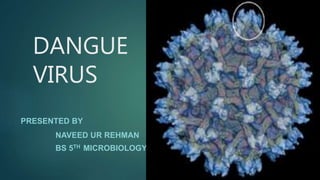
Dangue Virus
- 1. DANGUE VIRUS PRESENTED BY NAVEED UR REHMAN BS 5TH MICROBIOLOGY
- 2. Objectives: 1. Introduction 2. Classification 3. What is the Dengue Virus? 4. Epidemiology 5. Morphology of Dengue virus 6. Pathogenesis 7.Target tissues 8.Vector of Dengue virus 9.Symptoms 10.Morbidity and Mortality 11.Diagnostic tests 12.Treatment 13.Prevention
- 3. Objectives: 1. Introduction 11. Diagnostic tests 2. Classification treatment 3. What is the Dengue Virus? Prevention 4. Epidemiology 5. Morphology of Dengue virus 6. Pathogenesis 7. Target tissues 8. Vector of Dengue virus 9. Symptoms 10. Morbidity and Mortality
- 4. Introduction Dangue virus (DENV) is the cause of dengue fever It is a mosquito-borne disease It is single positive-stranded RNA virus Five serotypes of the virus have been found All of which cause the full spectrum of disease
- 5. Classification Group: Group IV ((+)ssRNA Order: Unassigned Family: Flaviviridae Genus: Flavivirus Species: Dengue virus
- 6. What is the Dengue Virus? It is Arbovirus, it can transmitted through arthropods i.e. mosquitoes Aedes aegypti is a vector for Dengue virus It is a pathogen that causes Break bone fever and dandy fever Dengue hemorrhagic fever (DHF) Can lead to Dengue shock syndrome (DSS)
- 7. Most these disease are cause by four different serotypes (DEN- 1,2,3,4) First reported epidemics in 1780 in Asia, Africa, and North America
- 8. Epidemiology Dengue occurs throughout much of the tropical and subtropical areas of world
- 9. Dengue became a world wide problem in the 1950’s though it rarely affects the US.
- 10. Morphology of Dengue virus Its is an enveloped virus It has a roughly spherical shape It is ssRNA virus It has E and M protein on envelope membrane
- 11. E protein are found as a dimer on the surface of the mature viral particle It is important in the initial attachment of this particle to the host cell M (membrane) protein, which is important in the formation and maturation of the viral particle
- 12. Pathogenesis Humans are initially infected through a mosquito vector Initial interaction with cell occurs with the viruses ability to infect cell Primary target, Phagocytes Virus uses cell receptor molecule to enter cell Cell receptor molecules include: Glycosaminoglycan Heparan Sulfate (Expressed in almost all cell types)
- 13. Virus replicates in target organs Virus is released and circulates in blood Alternate mosquito then bites host and receives virus
- 14. Target tissues Dengue induces cytokine production in cells Cytotoxic factor effects endothelial cells involved in most of the following: Heart Liver Kidneys Lungs Intestines Spleen Lymph node Brain Skin (inflammatory rashes)
- 15. Vector of Dengue virus Its vector is female Aedes aegypti. Characteristics of the Aedes Mosquito: One distinct physical feature – black and white stripes on its body and legs. Bites during the day. Lays its eggs in clean, stagnant water. Close-up of an Aedes mosquito
- 16. Only the female Aedes mosquito feeds on blood They need the protein found in blood to produce eggs. Male mosquitoes feed only on plant nectar. On average, a female Aedes mosquito can lay about 300 eggs during her life span of 14 to 21 days.
- 17. Life cycle of the Aedes Mosquito 1-2 days Stagnant water Pupae 4-5 days Larvae Eggs 2-3 days
- 18. How Do Aedes Mosquitoes Transmit Diseases... Mosquito bites and sucks blood containing the virus from an infected person. Virus is carried in its body. And passes the virus to healthy people when it bites them.
- 19. Symptoms Fever Headache Muscle and joint pain Dehydration Nausea and/or Hematemesis (vomiting of blood) Epistaxis (Bleeding from the nose, mouth, or gums) Haematuria (Blood in Urine) Pain behind the eyes Respiratory distress Petechia (Skin rash) and/or Purpura (Lesions)
- 20. The more severe form of Dengue is Dengue Hemorrhagic Fever.
- 21. Morbidity and Mortality More than 2.5 Billion people live in areas that have a risk of infection Over 100 million cases of Dengue infection are reported each year globally 500,000 cases pertain to DHF DHF has a 5% fatality rate for those infected People at high risk are children and the elderly
- 22. Diagnostic tests Virus isolation by infection of mice using infected mosquitoes Detection of IgM antibodies in the blood by PCR or Viral isolation (Serology) ELISA (Enzyme-Linked Immunoabsorbent assay) Stripe test
- 23. Treatment There is no specific treatment Symptomatic treatment is possible Vaccination Only one vaccine for dengue is currently approved in three countries (Brazil, Mexico, Philippines). Several vaccines are under development by private and public researchers Developing a vaccine against the disease is challenging
- 24. With four different serotypes of the dengue virus that can cause the disease, the vaccine must immunize against all four types to be effective. Vaccination against only one serotype could possibly lead to severe dengue hemorrhagic shock (DHS) when infected with another serotype due to antibody-dependent enhancement. When infected with dengue virus, the immune system produces cross-reactive antibodies that provide immunity to that particular serotype.
- 25. However, these antibodies are incapable of neutralizing other serotypes . Upon reinfection and actually increase viral replication. When macrophages consume the ‘neutralized’ virus, the virus is able to replicate within the macrophage, causing disease These cross-reactive, ineffective antibodies ease access of virus into macrophages, which induces more severe disease (dengue hemorrhagic fever, dengue shock syndrome).
- 26. Prevention Prevent Aedes from Breeding! Remove ALL sources of stagnant water. Deny the Aedes mosquito of any chance to breed.
- 27. Change water in vases on alternate days.
- 28. Remove water from flowerpot plates on alternate days.
- 29. Turn over all pails and water storage containers.
- 30. Use a mosquito net
- 31. Use insecticides spray and lotions
- 32. Thank you
